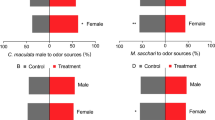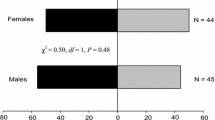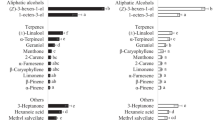Abstract
The two-spotted stinkbug, Perillus bioculatus, is a predator of the Colorado potato beetle (CPB), Leptinotarsa decemlineata. Behavioral tests revealed that P. bioculatus is attracted to potato plants, Solanum tuberosum L. (Solanaceae), infested by the CPB. Electroantennograms from the antennae of P. bioculatus were recorded in response to compounds present in the headspace of CPB-infested potato plants. (Z)-3-Hexen-1-ol and 2-phenylethanol elicited the highest EAG amplitudes. Linalool, 4,8-dimethyl-1,3(E),7-nonatriene, nonanal, decanal, and (R)-(+)-limonene evoked lower EAG amplitudes. The major headspace components β-caryophyllene and β-selinene produced only weak EAG responses. Antennal sensitivity of the CPB to (Z)-3-hexen-1-ol was higher than that of P. bioculatus, whereas the stinkburg was more sensitive to 2-phenylethanol, β-caryophyllene, (R)-(+)-limonene, and decanal. Among these compounds, 2-phenylethanol is of special interest since it was observed to be emitted by potato foliage only after being damaged by CPBs.
Similar content being viewed by others
REFERENCES
Aldrich, J. R. 1998. Status of semiochemical research on predatory Heteroptera, pp. 33-49, in M. Coll and J. Ruberson (eds.). Predatory Heteroptera in Agroecosystems: Their Ecology and Use in Biological Control. The Thomas Say Foundation, Entomology Society of America.
Aldrich, J. R., Kochansky, J. P., and Abrams, C. B. 1984. Attractant for a beneficial insect and its parasitoids: Pheromone of the spined soldier bug, Podisus maculiventris. Environ. Entomol. 13:1031-1036.
Aldrich, J. R., Oliver, J. E., Lusby, W. R., and Kochansky, J. P. 1986. Identification of male-specific exocrine secretions from predatory stink bugs (Hemiptera, Pentatomidae). Arch. Insect Biochem. Physiol. 3:1-12.
Arn, H., StÄdler, E., and Rauscher, S. 1975. The electroantennographic detector—a selective and sensitive tool in the gas chromatographic analysis of insect pheromones. Z. Naturforsch. C 30:722-725.
Biever, K. D., and Chauvin, R. L. 1992. Suppression of the Colorado potato beetle (Coleoptera: Chrysomelidae) with augmentative releases of predaceous stinkbugs (Hemiptera: Pentatomidae). J. Econ. Entomol. 89:720-726.
Bjegovic, P. 1970. The natural enemies of the Colorado potato beetle (Leptinotarsa decemlineata Say) and an attempt of its biological control in Yugoslavia. Zast. Bilja 21:97-111.
Bolter, C. J., Dicke, M., van Loon, J. J. A., Visser, J. H., and Posthumus, M. A. 1997. Attraction of Colorado potato beetle to herbivore-damaged plants during herbivory and after its termination. J. Chem. Ecol. 23:1003-1023.
Buttery, R. G., Ling, L. C., and Light, D. M. 1987. Tomato leaf volatile aroma components. J. Agric. Food Chem. 35:1039-1042.
Casagrande, R. A. 1987. The Colorado potato beetle: 125 years of mismanagement. Bull. Entomol. Soc. Am. 33:142-150.
Cloutier, C., and Bauduin, F. 1995. Biological control of the Colorado potato beetle Leptinotarsa decemlineata (Coleoptera: Chrysomelidae) in Quebec by augmentative releases of the two-spotted stinkbug Perillus bioculatus (Hemiptera: Pentatomidae). Can. Entomol. 127:195-212.
Dicke, M. 1994. Local and systemic production of volatile herbivore-induced terpenoids: Their role in plant-carnivore mutualism. J. Plant Physyiol. 143:465-472.
Dicke, M., and Sabelis, M. W. 1988. How plants obtain predatory mites as bodyguards. Neth. J. Zool. 38:148-165.
Dicke, M., Sabelis, M. W., Takabayashi, J., Bruin, J., and Posthumus, M. A. 1990. Plant strategies of manipulating predator-prey interactions through allelochemicals: Prospects for application in pest control. J. Chem. Ecol. 16:3091-3118.
Franz, J. M. 1966. Kolloquium der Arbeitsgruppe der O.I.L.B. Populationsdynamik und biologische Bekämpfung des Kartoffelkäfers. Entomophaga 11:470.
Franz, J. M. 1967. Beobachtungen über das Verhalten der Raubwanze Perillus bioculatus (Fabr.) (Pentatomidae) gegenüber ihrer Beute Leptinotarsa decemlineata (Say) (Chrysomelidae). Z. Pflanzen Krankh. Pflanzen schutz 74:1-13.
Heimpel, G. E., and Hough-Goldstein, J. A. 1994. Search tactics and response to cues by predatory stink bugs. Entomol. Exp. Appl. 73:193-197.
Hough-Goldstein, J., and Keil, C. B. 1991. Prospects for integrated control of the Colorado potato beetle (Coleoptera: Chrysomelidae) using Perillus bioculatus (Hemiptera: Pentatomidae) and various pesticides. J. Econ. Entomol. 84:1645-1651.
Jermy, T. 1980. The introduction of Perillus bioculatus into Europe to control the Colorado beetle. EPPO Bull. 10:475-479.
Pavis, C., and Renou, M. 1990. Étude de la forme des résponses électroantennographiques chez un Hétéroptère Pentatomidae [Nezara viridula (L.)]. C. R. Acad. Sci. Paris Ser. III 310:521-526.
Saint-Cyr, J.-F., and Cloutier, C. 1996. Prey preference by the stinkbug Perillus bioculatus, a predator of the Colorado potato beetle. Biol. Control 7:251-258.
Sant'ana, J., and Dickens, J. C. 1998. Comparative electrophysiological studies of olfaction in predaceous bugs, Podisus maculiventris and P. nigrispinus. J. Chem. Ecol. 24:965-984.
Sant'ana, J., Bruni, R., Abdul-Baki, A. A., and Aldrich, J. R. 1997. Pheromone-induced movement of nymphs of the predator, Podisus maculiventris (Heteroptera: Pentatomidae). Biol. Control 10:123-128.
Schneider, D. 1957. Elektrophysiologische Untersuchungen von Chemo-und Mechanorezeptoren der Antenne des Seidenspinners Bombyx mori L. Z. vergl. Physiol. 40:8-41.
SchÜtz, S., Weissbecker, B., Klein, A., and Hummel, H. E. 1997. Host plant selection of the Colorado potato beetle as influenced by damage induced volatiles of the potato plant. Naturwissenschaften 84:212-217.
Surburg, H., Guentert, M., and Harder, H. 1993. Volatile compounds from flowers: Analytical and olfactory aspects, pp. 168-186, in R. Teranishi, R. G. Buttery and H. Sugisawa (eds.). Bioactive volatile compounds from plants. ACS Symposium Series 525, American Chemical Society, Washington, D.C.
van Loon, J. J. A., de Vos, E., and Dicke, M. 1999. Orientation behaviour of the predatory hemipteran Perillus bioculatus to plant and prey odours. Submitted.
Visser, J. H. 1979. Electroantennogram responses of the Colorado beetle, Leptinotarsa decemlineata, to plant volatiles. Entomol. Exp. Appl. 25:86-97.
Visser, J. H., and AvÉ, D. A. 1978. General green leaf volatiles in the olfactory orientation of the Colorado beetle, Leptinotarsa decemlineata. Entomol. Exp. Appl. 24:738-749.
Weissbecker, B., SchÜtz, S., and Hummel, H. E. 1997a. Untersuchung der volatilen Emissionen der Kartoffelpflanze und ihrer Detektierbarkeit durch den Kartoffelkäfer mittels GC-MS, Elektroantennographie und GC-EAD, Mitt. Dtsch. Ges. Allg. Angew. Entomol. 11:357-361.
Weissbecker, B., SchÜtz, S., Klein, A., and Hummel, H. E. 1997b. Analysis of volatiles emitted by potato plants by means of a Colorado beetle electroantennographic detector. Talanta 44:2217-2224.
Author information
Authors and Affiliations
Rights and permissions
About this article
Cite this article
Weissbecker, B., Van Loon, J.J.A. & Dicke, M. Electroantennogram Responses of a Predator, Perillus bioculatus, and its Prey, Leptinotarsa decemlineata, to Plant Volatiles. J Chem Ecol 25, 2313–2325 (1999). https://doi.org/10.1023/A:1020825924703
Issue Date:
DOI: https://doi.org/10.1023/A:1020825924703




